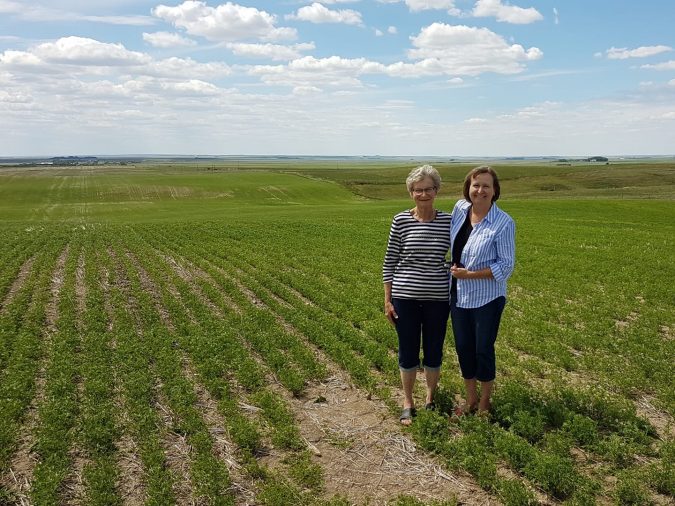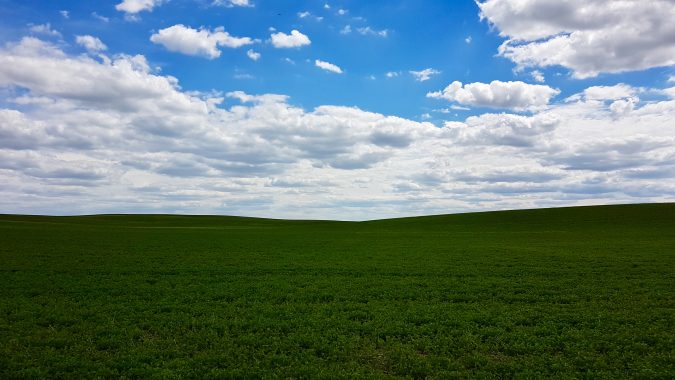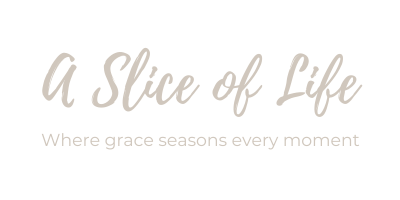When you know the truth of the past that has been lost in the fog of time . . . you become more solid and real.
Linda Joy Myers, Song of the Plains: A Memoir of Family, Sectets, and Silence

We’re driving across the prairie on another short leg of our LLF vacation, and cross the provincial border into Saskatchewan. The scenery gets good here and our imagination is ignited. Gerry comments on the melancholy of a grove of trees where there’s no longer a house or outbuildings in the middle of it.
A few hours later, we’re standing in just such a place with my cousin, Joyce, and her husband, Ted.
We stand at the top of a small hill and the warm wind whispers long since forgotten truth. I shoot a 360 degree video with my phone; it’s the most beautiful place. All around: green. Lentils grow here now—a modern day crop on the land that was farmed by my Letkeman grandparents, the land where my birth mom was born and raised, the land that was passed down to the oldest son who raised my three recently-connected-with cousins here.
A slight indentation in the earth is the only marker that remains of a house that stood here lifetimes ago. A grove of trees left standing is the melancholy beacon of all that was once here.
In the distance toward the west, Joyce points the way that she and her siblings ran across fields toward school; I imagine it was the same route taken by my birth mom for the eight years of her schooling.
It is just so beautiful here. To the untrained eye it’s endless green prairie; to me it’s the beginning—and the culmination. A number of years ago I made my way to the cemetery where she was buried; now I’m here on the land where my birth mom was born. A mother, once a secret kept from me, now returned to the extent that can be this side of heaven.
We stay here for a while. Memories are unearthed and spoken of while I soak in as much of the place as I can. I recall something I read once that said we carry place in our DNA. If that’s true there is something of this place in me. I have no trouble believing it.
In time, we return to the car and—Mennonite style—Joyce joins me in the back seat and Gerry takes the front passenger seat next to Ted. Conversation flows easily and gently. As I get to know my cousin more, I come to understand this family—my family—and stories I’ve heard snippets of and things I’ve imagined become tangible and real.
We dive a short way along gravel prairie roads, passing the site of the old school where only a tall wooden swing set remains, and arrive at the Mennonite Brethren church—a large modern building next to the place where the old church once stood. Joyce points out the place where our aunt once lived next to the church and tells me more about this eccentric woman who was, thirty-plus-years ago, the first point of contact with my birth family.
A little ways down the road we stop at little Mennonite Brethren cemetery and there we find the graves of our grandparents, Jacob and Mary. Ted goes back to the car and returns with a brush to clear the headstones so I can take a photograph of them.
It is about as close to a perfect day as I can imagine.



Linda, I just took a break from my manuscript where I had decided to add something about my two adopted girls when I saw this – wow, its is wondrous indeed the way people and places send messages to us just when we are ready to listen! Thankk you for this
It is, indeed, Jan. I look forward to reading your work when it’s time for it to go out into,the world too. 🙂
Love the descriptiveness of your writing. What a wonderful memory.
Thanks so much for stopping by, and for your kind words, Debbie.